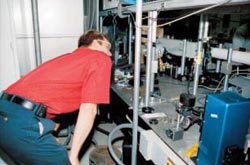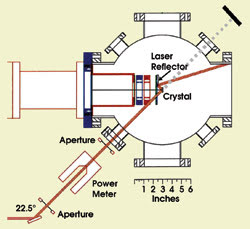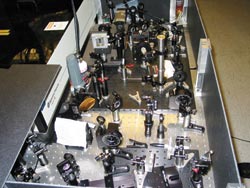Eye injuries are an integral part of the history of lasers, but with a cultural change among experimentalists, that need not be the case.
Kenneth L. Barat, Lawrence Livermore National Laboratory
One cannot help but wonder why laser eye accidents have not diminished in frequency as laser technology has matured over the years. Why have these injuries not been eradicated, like smallpox? Surely we understand the biological and psychological causes by now, yet every year there are dozens of injuries.
The answer, of course, is the simple carelessness that accompanies a familiarity with medium- and high-power lasers. This is particularly true in academic and high-tech research and development environments, where experiments are quickly assembled and where success depends more on ingenuity and inventiveness than on adherence to safety rules.
Every laser user this author has encountered has bypassed some common safety precaution in an effort to get the work done in what appeared as a faster or more efficient manner. An examination of the record of laser accidents reveals that, in virtually every case, the injury resulted from a shortcut taken by someone who should know better but who, in the interest of expediency, took an unnecessary, and ultimately very costly, risk.
The most common involves protective eyewear. Such eyewear is criticized for being uncomfortable to wear, for interfering with peripheral vision, for reducing visibility and for blocking precisely the wavelength that the laser user needs to see.
Each of these charges contains a grain of truth, but no more than that. Laser-safe eyewear is available in dozens of designs to minimize the discomfort and peripheral-vision blockage of users with and without regular eyeglasses. And although it necessarily attenuates the wavelength of the experimentalist’s laser, the knowledgeable laser safety officer can recommend controls or eyewear designed for laser alignment to provide protection while still allowing visualization of the beam.
Nonetheless, the failure to use protective eyewear is the common denominator of almost all laser eye accidents. Consider the following five cases at institutions within the US Department of Energy complex, where lack of eyewear, often coupled with other mistakes, resulted in dramatic effects not only to the individual, but also to the project — and, in some cases, to the institution where the accident happened.
Los Alamos National Laboratory. On July 14, 2004, an undergraduate student was injured at the Los Alamos lab in Albuquerque, N.M., while working with two flashlamp-pumped, Q-switched Nd:YAG lasers. She and her mentor were using one of the lasers to generate and suspend particles inside a target chamber, and the other laser to monitor the suspended particles. The two beams were perpendicular to each other: the particle-generating beam propagating vertically and the particle-monitoring beam propagating horizontally.
The scientist said that he needed to view the suspended particles in the chamber, so he disabled the Q-switch of the particle-monitoring laser but left its lamps flashing to illuminate the interior of the target chamber. He peered into the chamber off-axis, saw that the first laser was creating the particles and invited the student to look as well. When she viewed at a direct line of sight, she immediately saw a flash and a reddish-brown spot in her eye. The injury was subsequently diagnosed as laser-induced: The laser had vaporized a 400- × 250-μm hole through her fovea — the critical vision area on the retina — and into the underlying choroid layer.
Beyond the physical injury to the student, this accident helped precipitate a multiweek shutdown of all scientific work at the lab.
Neither the scientist nor the student was wearing protective eyewear at the time of the accident. Apparently, they assumed that the particle-monitoring laser was disabled and that the vertically propagating particle-generating laser posed no threat. Although the exact condition of the particle-monitoring laser at the time of the accident is unclear, it obviously was not disabled. Nor was its perceived safe mode confirmed prior to viewing.

A student suffered permanent vision loss by looking directly into the target chamber of a laser experiment without safety eyewear (recreated here). The injury resulted in a multiweek shutdown of all scientific work at the lab. Be conscientious that violating laser safety protocols poses not only a risk to the individual, but also a severe imposition to one’s colleagues.
The student’s retinal cells will not regenerate, and she has suffered a permanent loss of approximately one-third of the fovea of her left eye. Although her brain probably will compensate partially by filling in with vision from her right eye (her dominant eye), this will never be as good as her undamaged vision.
It would appear that two mistakes led to this accident. First, the investigators were not wearing the appropriate eyewear, probably because they felt that it hindered their performance of the experiment. Second, they incorrectly assumed that the laser was not lasing. Like an unloaded gun, a nonlasing laser is probably the most dangerous kind. The accident easily could have been avoided if the researchers had set up a CCD camera to observe the chamber, rather than putting their eyes at risk.
Brookhaven National Laboratory. In September 2003, two scientists at Brookhaven National Lab in Upton, N.Y., were aligning an alexandrite laser to excite fluorescence from a crystal in a target chamber when one of them sustained a permanent eye injury.

In one incident, a misaligned laser crystal resulted in an eye injury, lost work and a labwide shutdown. The accident could have been prevented with the use of safety eyewear or remote monitoring of the experiment. Be aware of the potential hazards in an experimental setup.
One scientist was observing the fluorescence as the other adjusted the laser, but the protective eyewear they were using made it difficult to see the fluorescence clearly, so the observer removed his eyewear. A slight misalignment of the laser caused its beam to miss the crystal and to emerge through the observation port. Unfortunately, the scientist was using a mirror to observe the fluorescence, and he unwittingly swept the beam across both his eyes. He suffered hemorrhaging and permanent vision impairment in both of his eyes.
The injured scientist was unable to work for a month, and although he has recovered some of his vision, he still is able to read only with difficulty. Besides the personal injury, the accident resulted in a multiweek halt of all laser-related work in the scientists’ division while an investigation was conducted.
The most obvious error in this incident was the lack of protective eyewear. Although eyewear that blocks infrared alexandrite radiation while passing most of the visible spectrum is available, an even safer alternative would have been to use a CCD camera to monitor the fluorescence.
Argonne National Laboratory. Observing fluorescence is just one of many reasons why experimentalists remove their protective eyewear. Last September, an experienced laser scientist at the Argonne lab’s Advanced Photon Source in Argonne, Ill., who was suffering from a slight eye infection, momentarily raised his eyewear to rub his eye.

The failure to wear protective eyewear is the common denominator in most laser eye accidents. Do not assume that an experimental setup is safe. Be sure to block all potential stray reflections from an optical bench, especially those leaving the horizontal plane of the setup.
At that moment, the experimentalist experienced what looked like a bright flash. Afterward, the vision in his left eye became cloudy. An examination revealed that he had suffered a laser burn of the retina when a polarizer on his optical bench reflected the beam of a Ti:sapphire laser into his eye.
Although the researcher’s vision has returned nearly to normal, all laser operations at the Advanced Photon Source were suspended for several weeks, and an extensive investigation was conducted of the entire laser safety program.
A second error was involved in this accident. A careful experimentalist blocks all stray reflections from his optical bench, especially those that leave the horizontal plane of the experiment. In this case, it was an unblocked beam angling up from the optical table that caused the injury.
University of California, Berkeley. An unfortunate habit adopted by some laser users is to strictly adhere to safety rules when setting up an experiment, but to relax their vigilance once it is running and “safe.”
Such was the case in March 2004, when a graduate student at the university sustained an eye injury from an Nd:YAG laser. He had carefully worn eyewear in the afternoon when he set up the experiment, but when he returned to take some data after dinner, he didn’t bother with eyewear because, he felt, there were no exposed beams that posed any danger. As he made a slight adjustment to a power meter, he saw a flash and heard a loud popping sound. He had sustained a serious injury to his left eye.

This retinal. burn, caused by an Nd:YAG rangefinder, resulted in nearly complete vision loss.
The student experienced some vision impairment months after the accident. Moreover, the incident led to a prolonged investigation and a significant decline in funding for the research group.
Argonne II. Although careless workers can sometimes emerge from laser accidents with little or no long-term vision impairment, they are not always so lucky.

A cultural change among experimentalists is required to make laser eye accidents, such as this retinal burn from an Nd:YAG, a thing of the past.
While manipulating the 800-nm beam from a Ti:sapphire laser with a mirror in October 2001, an Argonne scientist with more than 15 years’ laser experience suffered a serious eye injury. The beam had hit his unprotected eye.
Before the accident, his vision was 20/50. After the exposure, he was nearly blind. Even years later, he cannot read large print.
Ending injury
How can we prevent such laser accidents? Nothing short of a fundamental cultural change among laser experimentalists is required.
Such a cultural change would not be unprecedented. Forty years ago, seat belts were almost universally dismissed as an unwanted intrusion into the traveling experience, despite the fact that many cars came equipped with them. Today, nationwide safety belt use is 80 percent.
The use of laser eyewear has not fared as well during the same 40 years, but a similar modification in behavior and sentiment is essential. Some of the day-to-day activities that can lead to such a change and result in much greater safety in laser laboratories include:
• Co-workers challenging those who do not use protective eyewear.
• Treating evaluation for possible hazards as second nature, not as an afterthought.
• Safety professionals using reports of past accidents (lessons learned) to show how adhering to good practice could have prevented the injury.
• Reinforcing the consequences of an incident to the user and entire group so that users understand the impact they may impose on others as the result of a violation of laser safety protocols.
Meet the author
Kenneth L. Barat is the laser safety officer at Lawrence Livermore National Laboratory in Livermore, Calif.; e-mail: [email protected].
Developing a New Culture of Laser Safety
• Challenge co-workers who do not employ protective eyewear.
• Treat evaluation for possible hazards as second nature, not as an afterthought.
• Use safety reports of past accidents (lessons learned) to show how adhering to good practice could have prevented injury.
• Reinforce the consequences of an incident to the user and entire group so that all understand the impact they may impose on others as the result of a violation of laser safety protocols.